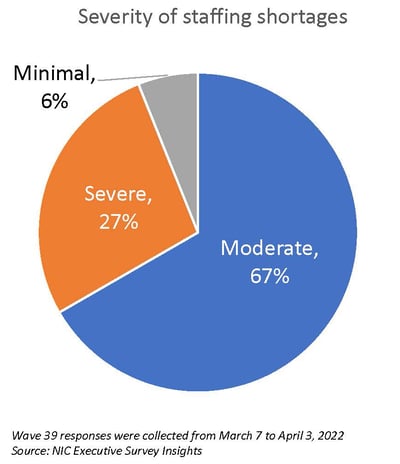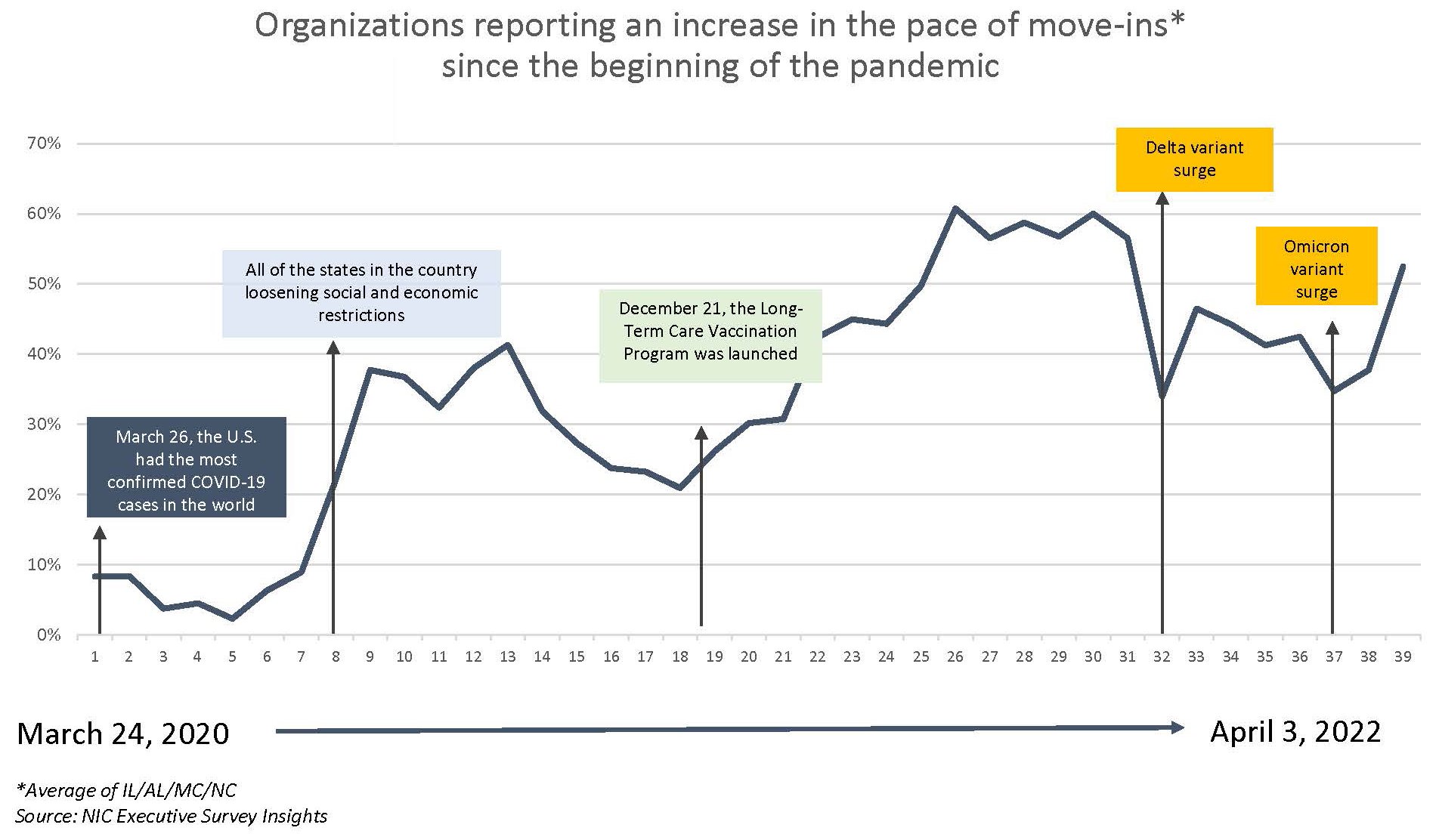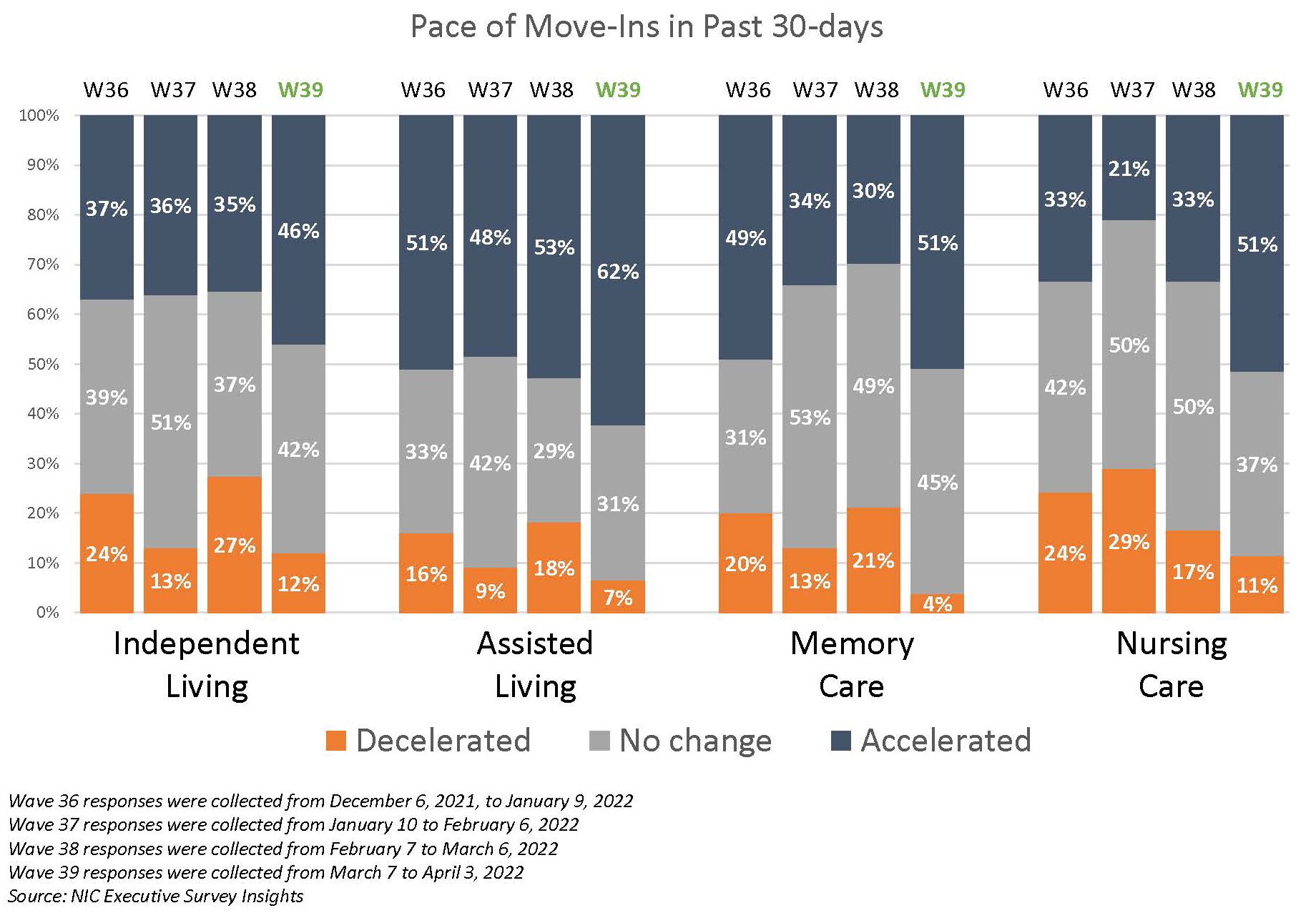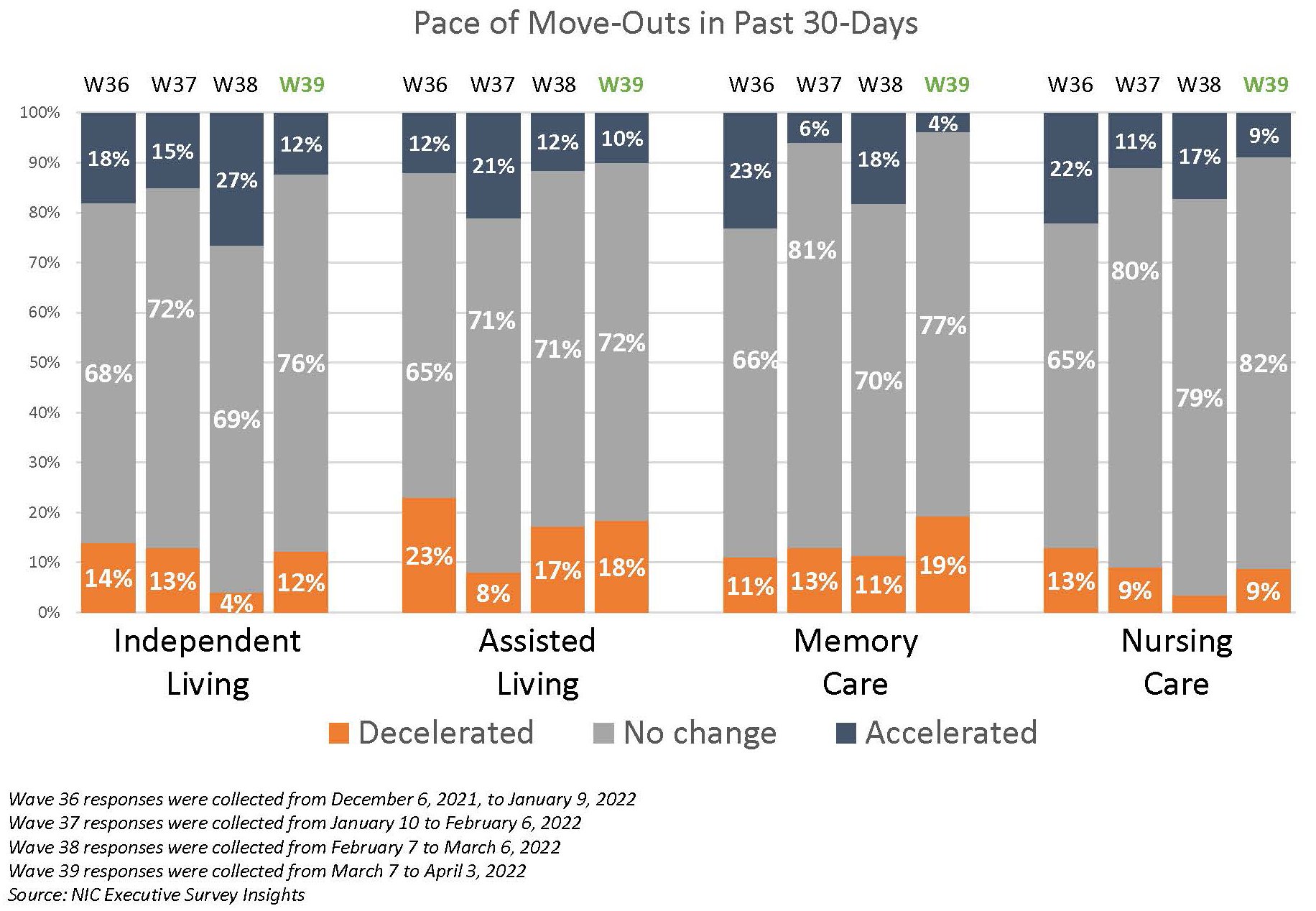Just over one-quarter of respondents noted that the severity of their staffing shortages across their organizations was severe, while two-thirds indicated the problem was moderate. Of significance, one-quarter of respondents had more than 20% of full-time positions currently unfilled. Regarding tenure of full-time employees, on average, just under one-half of organizations retained more than 80% on the job after one month. However, after one year, only 17% of organizations still had over 80% remaining on the job. Staffing shortages are often due to the inability to fill nursing aide positions, but wage competition and the inability to hire nurses also factored highly. Some alternative methods that have been successful in recruiting caregiving staff include offering daily pay, engaging resident marketing departments in developing staff recruiting strategies, providing housing in the community, offering flexible schedules that use different start times to accommodate childcare and school schedules, and more. Nearly nine out of ten organizations report that rising operating expenses are among their biggest challenges. NOI has been pressured for many operators due to the impact of labor shortages and higher wages, rising insurance costs, inflation-related higher-priced materials, and the pandemic-related decline in occupancy rates. Nearly 60% indicated that their operating expenses have increased between 6% and 14% since the beginning of the pandemic, with 30% reporting that expenses have risen 15% or more.
--Lana Peck, Senior Principal, NIC
NIC’s Executive Survey of senior housing and skilled nursing operators was implemented in March 2020 to deliver real-time insights into the impact of the pandemic and the pace of recovery. In its third year, the “ESI” is transitioning away from the COVID-19 crisis to focus on other industry challenges. While some standard questions will remain for tracking purposes, in each survey "wave," new questions will be added. To understand operators' labor and staffing issues, many new questions were added to Wave 39.
This Wave 39 survey includes responses from March 7 to April 3, 2022, from owners and executives of 69 small, medium, and large senior housing and skilled nursing operators across the nation, representing hundreds of buildings and thousands of units across respondents’ portfolios of properties. More detailed reports for each wave of the survey and a PDF of the report charts can be found on the NIC COVID-19 Resource Center webpage under Executive Survey Insights.
In the Wave 39 survey, just over one-quarter of respondents indicated the severity of their staffing shortages across their organizations was severe (27%), while two-thirds (67%) reported it was moderate. Attracting community and caregiving staff continues to be among operators’ most significant challenges. When asked about backfilling staff shortages, all of the respondents (100%) are paying overtime hours in Wave 39, and three-quarters (75%) are currently tapping agency or temp staff—down from a peak of 89% in the Wave 36 survey conducted in December 2021.

Roughly one-half of organizations reported that staffing shortages were due to the inability to fill nursing aide positions (54%). Wage competition (44%) and the inability to hire nurses (33%) were also commonly cited. Too much competition from other industries and staffing agencies was cited by roughly one-quarter of respondents (23%, respectively). Nevertheless, three-quarters of respondents (75%) are optimistic that staffing challenges will improve in the second half of 2022 or 2023.

Respondents were asked in the Wave 39 survey to share innovative methods they had found to be particularly successful in recruiting caregiving staff. Beyond generally increasing wages, offering flexible schedules, hiring and referral bonuses—all of which have been reported as effective to a greater or lesser degree—the list below includes some alternative ways to attract caregiving staff:
-
- Daily pay
- Scholarship programs/full tuition for nursing degrees
- Personalizing sign-on rewards and benefits to individuals
- Engaging resident sales and marketing staff in developing staff recruiting strategies
- Perfect attendance bonuses for new hires at the end of 30, 60, and 90 days
- Social media campaigns
- Dramatically increased wages by 10%-15% in the last six months
- Immediate phone follow-up after interviews
- Housing in the community
- Educating managers on how to manage more effectively in today’s environment
- Offering employees access to the community wellness programs and clinic
- Hiring in-house staff recruiters to update job ads every two days (acting as our own staffing agency)
- Reduced new hire paperwork and utilized online document signing tool--now getting people hired
and into communities in less than 24 hours
- Flexible schedules that use different start times to accommodate childcare and school schedules
- Hiring agency staffing that has worked in the community and wants to stay with us long-term
Regarding the current share of all full-time open positions across respondent organizations, significantly, one-quarter had more than 20% of positions currently unfilled. However, about one-third had 10% or less unfilled. Regarding tenure of full-time employees, on average, just under one-half of organizations kept more than 80% on the job after one month. However, after one year, only 17% of organizations still had over 80% remaining on the job.

Nearly nine out of ten organizations say that rising operating expenses are among their most significant challenges. Almost 60% indicated that their operating expenses have increased between 6% and 14%, with 30% reporting that expenses have risen 15% or more. Single-site organizations generally had lower increases in operating expenses than larger organizations with more properties in their portfolios.

Due to the pandemic, senior housing and care operators found it necessary to make greater use of technology for telehealth, resident and family communications, staff scheduling, and virtual and digital marketing. In 2022, more than half (55%) indicated that IT capital expenditures were between 5% and 10% of their total operating expenses. One-third (34%) reported that they were between 0% and 4%.
Across 39 waves of the ESI, the pace of move-ins has closely corresponded with the overall incidence of COVID-19 infection cases in the United States. This is demonstrated in the timeline below that shows the share of organizations reporting an increase in the pace of move-ins during the prior 30-days. Data from the Wave 39 survey, which was conducted in March, reflects an increase in the share of operators reporting acceleration in the pace of move-ins after the Omicron variant peaked and cases declined sharply in the U.S.

In the Wave 39 survey (reflecting operator experiences in March), between roughly 45% and 60% of organizations with independent living residences, assisted living residences, memory care residences, and nursing care beds reported an acceleration in the pace of move-ins. The largest increases were in higher acuity settings such as memory care and nursing care, but substantial increases were noted for assisted living and independent living, as well.
Most respondents reported no change in the pace of move-outs, which may support occupancy stability or increases in the coming months. While few organizations observed an acceleration in the pace of move-outs, of those that did, nearly three-quarters reported residents moving to higher levels of care (73%)—higher than in the Wave 38 survey (53%). This appears to be reflected in the large increases in the pace of move-ins in care segments serving residents with activities of daily living (ADL) needs.


Roughly 40% of respondents to the Wave 39 survey reported lead volumes above pre-pandemic levels in March—an increase from the prior survey (33%) reflecting results in February. Smaller operators are still less likely to have achieved lead volumes above pre-pandemic levels than larger organizations (as was noted in Wave 38), but single-site organizations saw the most significant gains. Single-site operators with lead volume above pre-pandemic levels rose from 15% to 40% in Wave 39. Given pent-up demand coming out of the pandemic and questions about the sustainability of record-high absorption rates in the last half of 2021 per NIC MAP Vision data, this measure in the ESI may be a leading indicator to watch with regards to occupancy recovery.
Wave 39 Survey Demographics
- Responses were collected between March 7 and April 3, 2022, from owners and executives of 69 senior housing and skilled nursing operators from across the nation. Owner/operators with 1 to 10 properties comprise roughly one-half (58%) of the sample. Operators with 11 to 25 and 26 properties or more make up the rest of the sample (1% and 25%, respectively).
- Just over one-half of respondents are exclusively for-profit providers (54%), about one-third operate not-for-profit seniors housing and care organizations (35%), and 11% operate both.
- Many respondents in the sample report operating combinations of property types. Across their entire portfolios of properties, 71% of the organizations operate seniors housing properties (IL, AL, MC), 22% operate nursing care properties, and 40% operate CCRCs (aka life plan communities).
Owners and C-suite executives of senior housing and care properties, please help us tell an accurate story about our industry’s performance. If you are an owner or C-suite executive of senior housing and care and have not received an email invitation to take the survey, please contact Lana Peck at lpeck@nic.org to be added to the list of recipients.
NIC wishes to thank respondents for their valuable input and continuing support for this effort to provide the broader market with a sense of the evolving landscape as we recover from the pandemic. This is your survey! Please take the Wave 40 survey and suggest new questions for Wave 41.
About Lana Peck
Lana Peck, former senior principal at the National Investment Center for Seniors Housing & Care (NIC), is a seniors housing market intelligence research professional with expertise in voice of customer analytics, product pricing and development, market segmentation, and market feasibility studies including demand analyses of greenfield developments, expansions, repositionings, and acquisition projects across the nation. Prior to joining NIC, Lana worked as director of research responsible for designing and executing seniors housing research for both for-profit and nonprofit communities, systems and national senior living trade organizations. Lana’s prior experience also includes more than a decade as senior market research analyst with one of the largest senior living owner-operators in the country. She holds a Master of Science, Business Management, a Master of Family and Consumer Sciences, Gerontology, and a professional certificate in Real Estate Finance and Development from Massachusetts Institute of Technology (MIT).
Connect with Lana Peck
Read More by Lana Peck